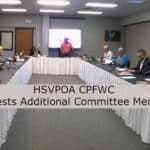There are a lot of issues to consider when working on daily operations and needed improvements to the Hot Springs Village Water and Wastewater Systems. The operation and improvement of water and wastewater systems do not come at a cheap cost. We often take our water and wastewater services for granted and do not realize the magnitude of the effort needed to keep these utilities going and updated. While these systems were probably sufficient at the time of original installation, some areas have experienced natural deterioration and are no longer a good fit for the Village. There has also been a large population increase. These critical areas are only part of what the Hot Springs Village Public Services Director, Ken Unger, has on his plate as he keeps the water flowing from the plant and wastewater flowing to the treatment plants. (Most of the information in this article comes from the January 11, 2024, Public Services Committee meeting.)
Cortez Lift Station Plans Are Progressing
Unger has been diligently working on the wastewater overflow problems on the west side of the Village since November 16, 2022, when he initially discovered the situation and realized there were past EPA violations. When Unger initially accepted the Hot Springs Village Public Services Director role, he was unaware of the sewage overflows. Unger and the team have been working to reduce these violations and hopefully completely eliminate them in the future. Click here to read a previous article about this situation. The work continues in this area, and Cortez Lift Station plans are progressing.
Unger said that the final plans and specs of the Cortez Lift Station were distributed to him and the Public Services Committee before the holidays. The Public Services Committee met Thursday afternoon with Entergy at the site to determine the best location for the transformer. Unger stated, “After we have the transformer location locked down, we will submit it for Health Department approval.”
Unger will determine what parts of this job can be done internally versus contracting out.
Replacement of Water Tanks?
Unger said that in 2023 the Committee discussed the need for two additional water tanks. (West and East) Unger said, “My current opinion is that the west side is the most critical because of the age of the B tanks. These tanks are the original. We just finished sealing one of them, but we still have a leak higher in the tank or in a line coming out of the tank. This is being evaluated. That tank is not long for life, and Unger believes two of the B tanks need to be decommissioned.
Peak Summer Water Usage Predicates Whether Additional Water Tanks are Needed
Unger said a lot of the discussion on the need for additional water tanks will “evolve around our rate structure for water and what we can do to control that demand in the summertime.”
Brian Wintel Was on Hand to Explain Technical Details for Water System Updates
The POA is working closely with Crist Engineering on many issues. Brian N. Wintle, Project Manager for Crist Engineers, Inc., sat in on the Public Services Committee meeting for consulting purposes.
Dealing with Elevation Changes and Pressure Zones
Wintel pointed out the various Hot Springs Village water pressure zones in a PowerPoint presentation. According to this document, “A pressure zone is defined as the area bounded by both a lower and upper elevation, all of which receives water from a given hydraulic grade line (HGL) or pressure from a set water surface. The HGL is usually provided by one or more storage tanks located at the same elevations so they share high and low water surfaces.”

The engineer explained, “Your distribution system is fairly unique and pretty extensive. This mainly has to do with topography. You have significant elevation changes from one side of the Village to the other, and you have all of these peaks and valleys in between.”
The bulk of the Village water lines is less than 12 inches in size, with many lines being 4, 6, and 8 inches. “Waterlines that go into a lot of the individual developments, neighborhoods, etc., are in that magnitude of size.”
Wintel asked, “How do we, from a bulk perspective, help out a pressure zone, rather than looking at each individual, small drilled-down neighborhood? That drilling down will come [in the future].”
Wintel explained that the system had pressure loggers employed for around 45 days. Pressure loggers are used to “verify low water pressure complaints, locate water pressure spikes, and provide water distribution system modeling data.” This gave us an initial look at how good our existing water distribution model is in real-world conditions. Good data is tantamount to planning.
“The challenge is, we are in the low-flow time frame,” explained Wintel. Due mainly to the irrigation of lawns, peak water usage is in the summer.
Unger said that we will redo the pressure logging in the peak water usage season, but our data now gives us the baseline. When we talk about the impact of the water rates, we can show peak versus base rates. We already know this from a production standpoint with the plant, but the pressure logging gives us the distribution system data.
The Village has continually expanded over the past 50-something years, and future growth was not always considered when water lines were installed. Wintel said we need improvements in water transmission and has listed the projects/improvements by priority.
Priority One
Priority one (short-term time frame) – Generally around one to seven years. The focus of priority one is to help Pressure Zone A by eliminating constrictions to allow for more efficient water transmission from the plant to Zone A. “If you can reduce the pressure drop when transmitting the water from the plant to the pressure zone, there are significant benefits,” explained Wintel. Unger said the initial estimates are around $6 M in today’s dollars to tackle this problem.
Priority Two
Priority two (mid-term time frame) – generally five to fifteen years. Wintel said priority two is to eliminate a constriction affecting the B Pressure Zone.
Priority Three
Priority three (long-term time frame) – generally ten to 20 years. – Improvements to B and C Pressure Zones.
Many Factors Affect the Need to Upgrade the HSV Water Distribution System
Many variables affect the need to upgrade the HSV water distribution system, including the amount of storage tanks available, the age of the tanks, transmission of water, water loss, and fire storage requirements. Currently, we have sufficient storage in case of fire. Unger said that irrigation on the east side is dramatic. The area feeding the east side needs to be upgraded, which is unsurprising.
Most Significant Weakness in HSV Water System
Unger feels our most significant weakness in the water system is that supplying the east side irrigation demand is difficult. The water lines for supplying this demand are currently 12-inch lines or less, and an upgrade to 16 to 18-inch lines is needed. Even though we do not reach maximum water usage year-round, the state requires us to have the capacity to provide maximum water usage at all times.
High Water Usage Affects All of Us
The water plant produces around 2.1 million gallons daily, and while sufficient for winter, this production does not meet peak summer usage requirements of over 4 million gallons per day. Unger estimates the summer increase is solely from irrigation.
“We need to make sure of our strategy on how to control this, because this affects all of us. The message we have to get out to the community is that peak flow in August determines what water system improvements are needed.”
Ken Unger, Hot Springs Village Public Services Director
Irrigation in the Village is inexpensive because our water rates do not encourage conservation, and we have a flat sewer rate. Currently, there is no incentive to conserve water usage. Unger would like for the Board of Directors to change this and implement an inverted block rate structure for water bills. Unger said, “We are not trying to gouge people for extra money. We are trying to address the issues in five years instead of pushing things ten to twenty years down the road.”
“We are looking at water consumption because we are trying to defer water plant improvements for as long as we possibly can, but in order to make that happen, we are looking at water rate changes to encourage conservation. We also encourage people to take a walk around their homes and look for wet spots in the yard [leaks] and listen to the toilet to see if your flapper valve is leaking. Initiating this communication with your neighbors in an informal way will not be a bad thing. It lets people know of the expectations going forward.”
Larry Siener, HSVPOA Board of Director and P. S. Committee Liaison
Click here to read “Hot Springs Village Water Rate – a Proposal.”
Unger said that replacing your toilet flappers may help conserve water and that this should be done once a year. Click here for instructions on how to replace your toilet flapper.
More information comes forward with additional investigation. Some of the information/plans we have from the past are incorrect, and Public Services and Crist Engineering continue to uncover the unknown. Because of new discoveries, plans will evolve over time.
“We will quickly hit the $15 to $20 M water improvement mark over the next five years.”
Ken Unger, Hot Springs Village Public Services Director
By Cheryl Dowden
Contact Information for HSVPOA Public Services Director
Ken Unger
Director Public Services
Hot Springs Village
501-226-9609
Kunger@hsvpoa.org
Click here to visit the Hot Springs Village POA Official Facebook Page.
We’d love to have you join our private Property Owners’ Facebook Group. Click here to join.








It was my understanding that we increased the Assessment Fees to deal with infrastructure improvements. It went up again this month. So why are we now talking about increased rates on water bills for repairs of infrastructure? They had a whole committee review these future needs and the POA got what was asked for to fix our infrastructure already.
Larry, good point that needs clarification. Act 605 will soon be a law and this act says that the water bills (and in our case, also the sewer bills) must cover all operational costs and needed improvements. When FRATF did its analysis, it was not aware of this new law. The POA will be obligated to match the input to the outgoing for utilities and we will no longer be able to subsidize our utility bills with assessment money. – Cheryl Dowden
The last water plant expansion was to 6 MGD. It was already 4 MGD.
from the article: “this production does not meet peak summer usage requirements of over 4 million gallons per day”
Jeff, from what I understand, the pipes are too small. So even though the capacity of the plant was increased, the ability to move the water was not. Public Services is actively working on plans to increase the distribution capacity. – Cheryl